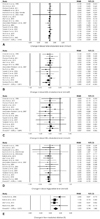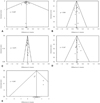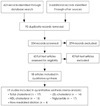Abstract
Purpose
Walnut is known to have unique favorable fatty acids, phytochemicals, and other nutrient profiles. As a result, there has been growing interest in evaluation of its health benefit related to cardiovascular disease (CVD). Although inverse associations of nut consumption and risk factors of cardiovascular disease have been reported in many epidemiological studies and qualitative reviews, few meta-analysis studies have been reported. This meta-analysis was conducted in order to evaluate the effect of a walnut-enhanced diet on CVD risk factors.
Methods
We searched Pubmed, Cochrane, Science Direct, and KISS (Korean studies Information Service System) through July 2014. A random-effects meta-analysis was conducted on 17 trials reporting total cholesterol (TC), 14 trials reporting LDL cholesterol (LDL-C), 15 trials reporting HDL cholesterol (HDL-C), 17 trials reporting triglyceride (TG), and four trials reporting flow-mediated dilation (FMD).
Results
In meta-analysis, intake of a walnut-enhanced diet resulted in significantly lowered TC, LDL-C, and TG by -0.124 mmol/l (95% CI, -0.209, -0.039; p = 0.004), -0.085 mmol/lL (95% CI, -0.167, -0.004; p = l0.039), and -0.080 mmol/l (95% CI, -0.155, -0.004; p = 0.039), respectively. The overall pooled estimate of the effect on FMD was +1.313% (95% CI, 0.744, 1.882, p = 0.000). HDL-C was not affected by walnut intake. No statistical heterogeneity was observed for any analysis. Results of funnel plots and Egger's regression suggested a low likelihood of publication bias in all biomarkers (p > 0.05).
Figures and Tables
Fig. 2
Forest plot results of the effect of walnut intake on A: total cholesterol, B: LDL-cholesterol, C: HDL-cholesterol, D: Triglyceride, E: Flow-mediated dilation.

Fig. 3
Funnel plot showing the effect of the walnut intake on changes in A: Total cholesterol, B: LDL-cholesterol, C: HDL-cholesterol, D: Triglyceride, E: Flow-mediated dilation.

References
1. Hansson GK. Inflammation, atherosclerosis, and coronary artery disease. N Engl J Med. 2005; 352(16):1685–1695.

2. Statistics Korea. 2012 statistics on causes of death. Daejeon: Statistics Korea;2013.
3. Mozaffarian D, Wilson PW, Kannel WB. Beyond established and novel risk factors: lifestyle risk factors for cardiovascular disease. Circulation. 2008; 117(23):3031–3038.
4. National Academy of Agricultural Science. Food composition table [Internet]. Wanju: National Academy of Agricultural Science;2006. cited 2014 Jul 16. Available from: http://koreanfood.rda.go.kr/fct/Fct_Intro.aspx.
5. United States Department of Agriculture. USDA national nutrient database for standard reference, Release 26 [Internet]. Washington, D.C.: United States Department of Agriculture;2013. cited 2014 Jul 16. Available from: http://ndb.nal.usda.gov/ndb/search/list.
6. Sabaté J, Ang Y. Nuts and health outcomes: new epidemiologic evidence. Am J Clin Nutr. 2009; 89(5):1643S–1648S.

7. Li TY, Brennan AM, Wedick NM, Mantzoros C, Rifai N, Hu FB. Regular consumption of nuts is associated with a lower risk of cardiovascular disease in women with type 2 diabetes. J Nutr. 2009; 139(7):1333–1338.

8. Mukuddem-Petersen J, Oosthuizen W, Jerling JC. A systematic review of the effects of nuts on blood lipid profiles in humans. J Nutr. 2005; 135(9):2082–2089.

9. Phung OJ, Makanji SS, White CM, Coleman CI. Almonds have a neutral effect on serum lipid profiles: a meta-analysis of randomized trials. J Am Diet Assoc. 2009; 109(5):865–873.

10. Taylor SE. Qualified health claims: letter of enforcement discretion - Walnuts and Coronary Heart Disease (Docket No 02P-0292) [Internet]. Silver Spring (MD): U.S. Food and Drug Administration;2004. cited 2014 Jul 16. Available from: http://www.fda.gov/Food/IngredientsPackagingLabeling/LabelingNutrition/ucm072910.htm.
11. EFSA Panel on Dietetic Products, Nutrition and Allergies (NDA). Scientific opinion on the substantiation of health claims related to walnuts and maintenance of normal blood LDL-cholesterol concentrations (ID 1156, 1158) and improvement of endothelium-dependent vasodilation (ID 1155, 1157) pursuant to Article 13(1) of Regulation (EC) No 1924/2006. EFSA J. 2011; 9(4):2074.
12. Banel DK, Hu FB. Effects of walnut consumption on blood lipids and other cardiovascular risk factors: a meta-analysis and systematic review. Am J Clin Nutr. 2009; 90(1):56–63.

13. Ministry of Food and Drug Safety. Guidance for the evaluation on the functionality of health functional food. Cheongju: Ministry of Food and Drug Safety;2008.
14. United States Food and Drug Administration. Guidance for industry: evidence-based review system for the scientific evaluation of health claims. Silver Spring (MD): United States Food and Drug Administration;2009. cited 2014 Jul 16. Available from: http://www.fda.gov/Food/GuidanceRegulation/GuidanceDocumentsRegulatoryInformation/LabelingNutrition/ucm073332.htm.
15. EFSA Panel on Dietetic Products, Nutrition and Allergies (NDA). Scientific and technical guidance for the preparation and presentation of an application for authorisation of a health claim (revision 1). EFSA J [Internet]. 2011. 9(5):2170. cited 2014 Jul 16. Available from: http://www.efsa.europa.eu/en/efsajournal/pub/2170.htm.
16. Kim JY, Jeong S, Paek JE, Kim J, Kwak JS, Lee YJ, Kang TS, Kwon O. Systematic review of the effect of coenzyme Q10 on antioxidant capacity while focused on evaluation of claims for health functional food. J Nutr Health. 2013; 46(3):218–225.

17. Jeong S, Kim JY, Paek JE, Kim J, Kwak JS, Kwon O. Systematic review of the effect of omega-3 fatty acids on improvement of blood flow while focused on evaluation of claims for health functional food. J Nutr Health. 2013; 46(3):226–238.

18. Kim JY, Kwon O. Garlic intake and cancer risk: an analysis using the Food and Drug Administration's evidence-based review system for the scientific evaluation of health claims. Am J Clin Nutr. 2009; 89(1):257–264.

19. Higgins JP, Green S. Cochrane handbook for systematic reviews of interventions version 5.1.0. Oxford: The Cochrane Collaboration;2011.
20. Chisholm A, Mann J, Skeaff M, Frampton C, Sutherland W, Duncan A, Tiszavari S. A diet rich in walnuts favourably influences plasma fatty acid profile in moderately hyperlipidaemic subjects. Eur J Clin Nutr. 1998; 52(1):12–16.

21. Cortés B, Núñez I, Cofán M, Gilabert R, Pérez-Heras A, Casals E, Deulofeu R, Ros E. Acute effects of high-fat meals enriched with walnuts or olive oil on postprandial endothelial function. J Am Coll Cardiol. 2006; 48(8):1666–1671.

22. Din JN, Aftab SM, Jubb AW, Carnegy FH, Lyall K, Sarma J, Newby DE, Flapan AD. Effect of moderate walnut consumption on lipid profile, arterial stiffness and platelet activation in humans. Eur J Clin Nutr. 2011; 65(2):234–239.

23. Fitschen PJ, Rolfhus KR, Winfrey MR, Allen BK, Manzy M, Maher MA. Cardiovascular effects of consumption of black versus English walnuts. J Med Food. 2011; 14(9):890–898.

24. Haddad EH, Gaban-Chong N, Oda K, Sabaté J. Effect of a walnut meal on postprandial oxidative stress and antioxidants in healthy individuals. Nutr J. 2014; 13:4.

25. Iwamoto M, Imaizumi K, Sato M, Hirooka Y, Sakai K, Takeshita A, Kono M. Serum lipid profiles in Japanese women and men during consumption of walnuts. Eur J Clin Nutr. 2002; 56(7):629–637.

26. Katz DL, Davidhi A, Ma Y, Kavak Y, Bifulco L, Njike VY. Effects of walnuts on endothelial function in overweight adults with visceral obesity: a randomized, controlled, crossover trial. J Am Coll Nutr. 2012; 31(6):415–423.

27. Ma Y, Njike VY, Millet J, Dutta S, Doughty K, Treu JA, Katz DL. Effects of walnut consumption on endothelial function in type 2 diabetic subjects: a randomized controlled crossover trial. Diabetes Care. 2010; 33(2):227–232.
28. Morgan JM, Horton K, Reese D, Carey C, Walker K, Capuzzi DM. Effects of walnut consumption as part of a low-fat, low-cholesterol diet on serum cardiovascular risk factors. Int J Vitam Nutr Res. 2002; 72(5):341–347.

29. Mukuddem-Petersen J, Stonehouse Oosthuizen W, Jerling JC, Hanekom SM, White Z. Effects of a high walnut and high cashew nut diet on selected markers of the metabolic syndrome: a controlled feeding trial. Br J Nutr. 2007; 97(6):1144–1153.

30. Ros E, Núñez I, Pérez-Heras A, Serra M, Gilabert R, Casals E, Deulofeu R. A walnut diet improves endothelial function in hypercholesterolemic subjects: a randomized crossover trial. Circulation. 2004; 109(13):1609–1614.
31. Schutte AE, Van Rooyen JM, Huisman HW, Mukuddem-Petersen J, Oosthuizen W, Hanekom SM, et al. Modulation of baroreflex sensitivity by walnuts versus cashew nuts in subjects with metabolic syndrome. Am J Hypertens. 2006; 19(6):629–636.

32. Tapsell LC, Gillen LJ, Patch CS, Batterham M, Owen A, Baré M, Kennedy M. Including walnuts in a low-fat/modified-fat diet improves HDL cholesterol-to-total cholesterol ratios in patients with type 2 diabetes. Diabetes Care. 2004; 27(12):2777–2783.

33. Tapsell LC, Batterham MJ, Teuss G, Tan SY, Dalton S, Quick CJ, Gillen LJ, Charlton KE. Long-term effects of increased dietary polyunsaturated fat from walnuts on metabolic parameters in type II diabetes. Eur J Clin Nutr. 2009; 63(8):1008–1015.

34. Torabian S, Haddad E, Cordero-MacIntyre Z, Tanzman J, Fernandez ML, Sabate J. Long-term walnut supplementation without dietary advice induces favorable serum lipid changes in free-living individuals. Eur J Clin Nutr. 2010; 64(3):274–279.

35. Wu H, Pan A, Yu Z, Qi Q, Lu L, Zhang G, Yu D, Zong G, Zhou Y, Chen X, Tang L, Feng Y, Zhou H, Chen X, Li H, Demark-Wahnefried W, Hu FB, Lin X. Lifestyle counseling and supplementation with flaxseed or walnuts influence the management of metabolic syndrome. J Nutr. 2010; 140(11):1937–1942.

36. Wu L, Piotrowski K, Rau T, Waldmann E, Broedl UC, Demmelmair H, Koletzko B, Stark RG, Nagel JM, Mantzoros CS, Parhofer KG. Walnut-enriched diet reduces fasting non-HDL-cholesterol and apolipoprotein B in healthy Caucasian subjects: a randomized controlled cross-over clinical trial. Metabolism. 2014; 63(3):382–391.

37. Zambón D, Sabaté J, Muñoz S, Campero B, Casals E, Merlos M, Laguna JC, Ros E. Substituting walnuts for monounsaturated fat improves the serum lipid profile of hypercholesterolemic men and women. A randomized crossover trial. Ann Intern Med. 2000; 132(7):538–546.
38. Feldman EB. The scientific evidence for a beneficial health relationship between walnuts and coronary heart disease. J Nutr. 2002; 132(5):1062s–1101s.

39. Yokoyama M, Origasa H, Matsuzaki M, Matsuzawa Y, Saito Y, Ishikawa Y, Oikawa S, Sasaki J, Hishida H, Itakura H, Kita T, Kitabatake A, Nakaya N, Sakata T, Shimada K, Shirato K. Japan EPA lipid intervention study (JELIS) Investigators. Effects of eicosapentaenoic acid on major coronary events in hypercholesterolaemic patients (JELIS): a randomised open-label, blinded endpoint analysis. Lancet. 2007; 369(9567):1090–1098.

40. Bucher HC, Hengstler P, Schindler C, Meier G. N-3 polyunsaturated fatty acids in coronary heart disease: a meta-analysis of randomized controlled trials. Am J Med. 2002; 112(4):298–304.

41. Whelton SP, He J, Whelton PK, Muntner P. Meta-analysis of observational studies on fish intake and coronary heart disease. Am J Cardiol. 2004; 93(9):1119–1123.

42. Xun P, Qin B, Song Y, Nakamura Y, Kurth T, Yaemsiri S, Djousse L, He K. Fish consumption and risk of stroke and its subtypes: accumulative evidence from a meta-analysis of prospective cohort studies. Eur J Clin Nutr. 2012; 66(11):1199–1207.

43. Inaba Y, Chen JA, Bergmann SR. Prediction of future cardiovascular outcomes by flow-mediated vasodilatation of brachial artery: a meta-analysis. Int J Cardiovasc Imaging. 2010; 26(6):631–640.

44. Ras RT, Streppel MT, Draijer R, Zock PL. Flow-mediated dilation and cardiovascular risk prediction: a systematic review with meta-analysis. Int J Cardiol. 2013; 168(1):344–351.

46. Pongrojpaw D, Somprasit C, Chanthasenanont A. A randomized comparison of ginger and dimenhydrinate in the treatment of nausea and vomiting in pregnancy. J Med Assoc Thai. 2007; 90(9):1703–1709.




 PDF
PDF ePub
ePub Citation
Citation Print
Print






 XML Download
XML Download